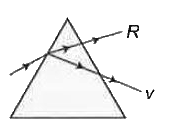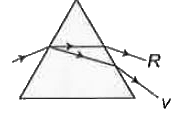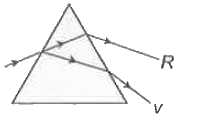Is deviation always followed by dispersion ?
Not necessarily. Total reflection prism does not produce dispersion.
Topper's Solved these Questions
- BOOK - AAKASH INSTITUTECHAPTER - RAY OPTICS AND OPTICAL INSTRUMENTSEXERCISE - Assignment (Section - A) Objective Type Questions (One option is correct)38videos
RAY OPTICS AND OPTICAL INSTRUMENTS
- BOOK - AAKASH INSTITUTECHAPTER - RAY OPTICS AND OPTICAL INSTRUMENTSEXERCISE - Assignment (Section - B) Objective Type Questions (One option is correct)16videos
RAY OPTICS AND OPTICAL INSTRUMENTS
- BOOK - AAKASH INSTITUTECHAPTER - PHYSICAL WORLDEXERCISE - ASSIGNMENT (Section-B)5videos
PHYSICAL WORLD
- BOOK - AAKASH INSTITUTECHAPTER - SEMICONDUCTOR ELECTRONICS (MATERIAL, DEVICES AND SIMPLE CIRUITS )EXERCISE - Assignment SECTION - D (Assertion & reason type Question)10videos
SEMICONDUCTOR ELECTRONICS (MATERIAL, DEVICES AND SIMPLE CIRUITS )
Similar Questions
When a white light passes through a hollow prism, then there is dispersion but no deviation deviation but no dispersion no dispersion and no deviation dispersion and deviation both
View SolutionStand deviation is a better measure of dispersion compared to mean deviation as it is based on the squares of deviations from the mean.
(true/False)View Solution
Knowledge Check
- Question 1 - Select One
For two given statements :
(1) A prism can produce a minimum deviation D in a light ray. If three such prism are combined, the minimum deviation that can be obtained with this combination is 3 D.
(2) A combination of two prisms produce deviation as well as dispersion when monochromatic light is incident upon it.A true 2 falseB1 false 2 trueCboth trueDboth false - Question 2 - Select One
A ray of light passes through a prism whose refracting angle is 5∘ and dispersive power is 0.03. The refractive index for the mean ray in a spectrum is 1.62. The mean deviation and angle of dispersion respectively are
A3.1∘,0.077∘B3.1∘,0.093∘C6.2∘,0.093∘D6.2∘,0.077∘ - Question 3 - Select One
Which of the following figures shows a correct representations of deviation and dispersion of light by a prism?
A B
B C
C D
D
Why should we measure dispersion about some particular value? Do the range and quartile deviation measure dispersion about some values?
View SolutionDeviation without dispersion and disperison without deviation
What should be the condition on a combination of prism for the following ?
(a) Angle of dispersion is zero but angle of deviation is not zero.View SolutionStatement-1 : Two prism joined in opposite alone can produce dispersion without deviation or deviation without dispersion.
Statement-2 : Dispersion is due to different deviation only.View SolutionIn the visible region the dispersive powers and the mean angular deviations for crown and flint glass prisms are ω',ω' and d,d respectively. The condition for getting deviation without dispersion when the two prisms are combined is
View SolutionIn the visible region the dispersive powers and the mean angular deviations for crown and flint glass prisms are ω',ω' and d,d respectively. The condition for getting deviation without dispersion when the two prisms are combined is
View Solution

